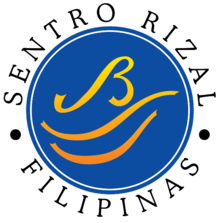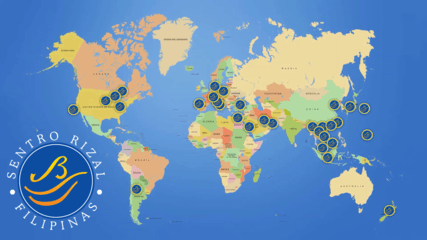Sentro Rizal
The Sentro Rizal is a Philippine government-sponsored organization whose main objective is the global promotion of Filipino art, culture and language.[1] Established by virtue of the National Cultural Heritage Act of 2009, its headquarters is located at the National Commission for Culture and the Arts (NCCA) office in Intramuros, Manila. Sentro Rizal aims to promote Philippine arts, culture, and language throughout the world through the establishment of Philippine centers in various countries which initiate and organize cultural training programs and activities for overseas Filipinos.
 | |
| Cultural Center overview | |
|---|---|
| Formed | 2009 |
| Headquarters | NCCA Building, 633 General Luna Street, Intramuros, Manila |
| Parent Cultural Center | National Commission for Culture and the Arts |
| Website | www |
Sentro Rizal is named after Dr. José Rizal, the Philippines' acclaimed national hero, writer, and polymath. His works Noli Me Tángere and El Filibusterismo are acknowledged to have sparked the country's quest for independence in 1898. He championed love of family and country, peace, freedom, human dignity, knowledge, use of local language, bravery, women's role in nation building, unity, compassion, productive involvement of the youth, among others.
Logo
The official logo of the Sentro Rizal is composed of two elements, the balangay and baybayin which are both significant to Filipino heritage. The letters "S" and "R" are rendered in the ancient Filipino syllabic script known as baybayin and are stylized to form a balangay, an ancient Philippine edged-pegged plank boat, reflecting the maritime heritage of the Philippines and depicting the character of Filipino migrants. The balangay also represents the quest of individuals in exploring the real essence of Filipino identity through culture and arts.
The Sentro Rizal acts as the balangay which provides overseas Filipinos and their children the means to connect to their roots – instilling a strong sense of nationhood and pride among them in being Filipinos.
The color of the Sentro Rizal logo was patterned from NCCA's logo – blue and gold.
Cultural centers
As of January 2020, there are 35 Sentros Rizal in the following locations:[2]

| Country | City | Country | City | ||
| A | Argentina | Buenos Aires | N | New Zealand | Wellington |
| Australia | Sydney | O | Oman | Muscat | |
| B | Bahrain | Manama | Q | Qatar | Doha |
| Brunei | Brunei | S | Saudi Arabia | Jeddah | |
| C | Cambodia | Phnom Penh | Singapore | Singapore | |
| Canada | Ottawa | South Korea | Seoul | ||
| Toronto | Spain | Madrid | |||
| China | Beijing | Switzerland | Berne | ||
| Hong Kong | T | Thailand | Bangkok | ||
| Xiamen | Turkey | Ankara | |||
| E | Egypt | Cairo | U | United Arab Emirates | Abu Dhabi |
| G | Germany | Berlin | United Kingdom | London | |
| I | Italy | Milan | United States
of America |
Agana | |
| Rome | Chicago | ||||
| Indonesia | Jakarta | Los Angeles | |||
| J | Japan | Tokyo | San Francisco | ||
| L | Laos | Vientiane | Washington, D.C. | ||
| M | Myanmar | Yangon | |||
Activities and programs
In 2015, the first Filipino language pilot class was conducted in Phnom Penh, Cambodia. Twenty-four students completed the first beginner's level language class, dubbed "Masayang Matuto ng Filipino".
The Commission on Filipinos Overseas has made use of digital media in disseminating Filipiniana for overseas Filipinos, called the "Virtual Sentro Rizal". This Filipiniana collection consist of 250 gigabytes of data including 72 hours of video of Filipino cultural materials covering different genres across regions.[3]
See also
References
- Villalon, Augusto (26 April 2010). "New heritage law seeks to establish Sentro Rizal across the globe". Philippine Daily Inquirer.
- "Sentro Rizal - Branches". National Commission for Culture and the Arts. Retrieved 7 Aug 2019.
- Medina, Andrei (26 February 2013). "'Sentro Rizal' digital collection of Filipiniana to help Pinoys appreciate heritage". GMA News and Public Affairs.